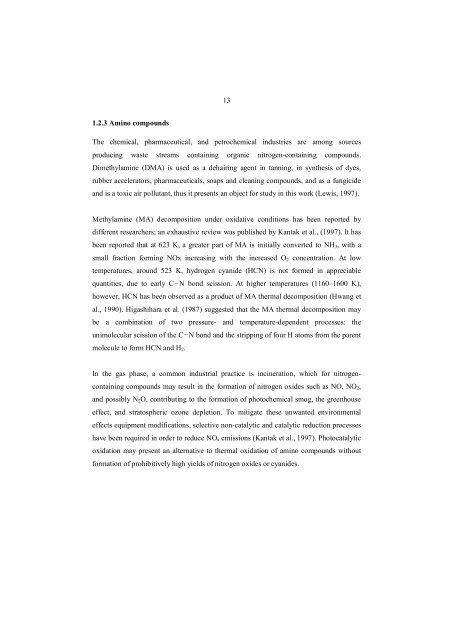gas-phase photocatalytic oxidation of volatile organic ... - Doria
gas-phase photocatalytic oxidation of volatile organic ... - Doria
gas-phase photocatalytic oxidation of volatile organic ... - Doria
Create successful ePaper yourself
Turn your PDF publications into a flip-book with our unique Google optimized e-Paper software.
1.2.3 Amino compounds<br />
13<br />
The chemical, pharmaceutical, and petrochemical industries are among sources<br />
producing waste streams containing <strong>organic</strong> nitrogen-containing compounds.<br />
Dimethylamine (DMA) is used as a dehairing agent in tanning, in synthesis <strong>of</strong> dyes,<br />
rubber accelerators, pharmaceuticals, soaps and cleaning compounds, and as a fungicide<br />
and is a toxic air pollutant, thus it presents an object for study in this work (Lewis, 1997).<br />
Methylamine (MA) decomposition under oxidative conditions has been reported by<br />
different researchers; an exhaustive review was published by Kantak et al., (1997). It has<br />
been reported that at 623 K, a greater part <strong>of</strong> MA is initially converted to NH3, with a<br />
small fraction forming NOx increasing with the increased O2 concentration. At low<br />
temperatures, around 523 K, hydrogen cyanide (HCN) is not formed in appreciable<br />
quantities, due to early C�N bond scission. At higher temperatures (1160–1600 K),<br />
however, HCN has been observed as a product <strong>of</strong> MA thermal decomposition (Hwang et<br />
al., 1990). Hi<strong>gas</strong>hihara et al. (1987) suggested that the MA thermal decomposition may<br />
be a combination <strong>of</strong> two pressure- and temperature-dependent processes: the<br />
unimolecular scission <strong>of</strong> the C�N bond and the stripping <strong>of</strong> four H atoms from the parent<br />
molecule to form HCN and H2.<br />
In the <strong>gas</strong> <strong>phase</strong>, a common industrial practice is incineration, which for nitrogen-<br />
containing compounds may result in the formation <strong>of</strong> nitrogen oxides such as NO, NO2,<br />
and possibly N2O, contributing to the formation <strong>of</strong> photochemical smog, the greenhouse<br />
effect, and stratospheric ozone depletion. To mitigate these unwanted environmental<br />
effects equipment modifications, selective non-catalytic and catalytic reduction processes<br />
have been required in order to reduce NOx emissions (Kantak et al., 1997). Photocatalytic<br />
<strong>oxidation</strong> may present an alternative to thermal <strong>oxidation</strong> <strong>of</strong> amino compounds without<br />
formation <strong>of</strong> prohibitively high yields <strong>of</strong> nitrogen oxides or cyanides.

















